#swimming with sharks 1994
Text


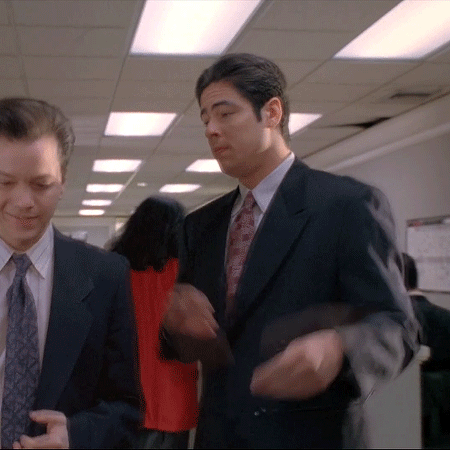


BENICIO DEL TORO as REX
SWIMMING WITH SHARKS
1994 | dir. George Huang
#he is serving in this movie lmao why did they make him so bitchy#benicio del toro#bdtedit#beniciodeltoroedit#swimming with sharks 1994#*benicioscenes.gif#mine#REX#rexedit
44 notes
·
View notes
Photo


Swimming with Sharks 1994 - Buddy Ackerman (Kevin Spacey)
0 notes
Text
[Review] Sega Pocket Arcade: Ecco the Dolphin (1995)

A rare dolphin treat.
A while ago I bought the Sega Pocket Arcade: Ecco the Dolphin from 1994 (pictured on the left, below). Much to my dismay, problems with the unit design caused hardware issues that rendered the game unplayable. Still, it’s a great collector’s item in a unique form factor. However, a much rarer item is the second Ecco the Dolphin handheld from 1995-according to the back of the unit (pictured on the right)-or 1997 going by the packaging. Although Tiger is often credited for the initial “red label” games in this line, their branding is absent from the packaging so Sega of America may have internally developed the first model and manufactured it in the US, but the 1995 blue label model was certainly and proudly developed by the experienced LCD game company Tiger and made in China… and by the way, the hardware did not almost instantly fail on me.
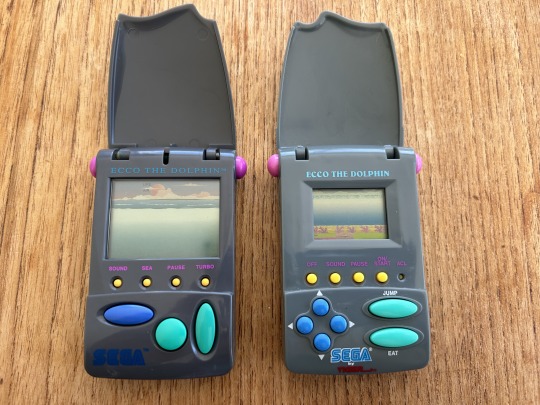
Sega’s initial Pocket Arcade line had a few different case designs, some with slide-out screens. Their clamshell units included Ecco, Columns, and Football. When Tiger took over, all of their line, such as this second Ecco, Nights, and the enticing Panzer Dragoon, used the screen-protecting clamshell design. They also seem to universally use a much smaller inset screen compared to the first lineup, no doubt a cost-saving measure that unfortunately hampers playability somewhat.
Now, observe the two units side by side. Note the differences in screen layout and button distribution. These are in fact two completely separate games with differing design, graphics, and controls. Both have Ecco auto-swimming to the right, avoiding hostile sea life over a number of levels, but each has unique features. The first game has an active sonar mechanic, which can reveal tunnels to swim through (similar to the OG dolphin game, Activision’s Dolphin) and interact with glyphs. It has a speed control mechanic, hazardous seagulls above the waves, and dolphin family members to rescue, not to mention descriptive level write-ups in the manual.
By contrast, this second unit seems simpler, more of a straightforward survival game. But there’s enough depth for an LCD game, with three planes of action and the life/air bars to juggle. Surfacing for air is necessary but sometimes blocked by a jellyfish, and health can be refilled by tapping the Eat button on the lower lane when a fish comes along amongst the coral. There are many hazards on the bottom layer to be wary of, though.
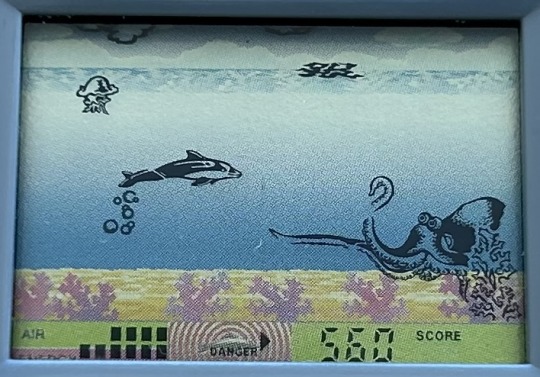
The biggest foe is the octopus who emerges from the right to menace two lanes with tentacular ferocity! Combine this with a jelly up top and you’re in a right pickle. However, a back-dodge can grant temporary sanctuary especially when chained together. More types of sharks appear as the levels progress to threaten each lane, and other, more difficult to identify, creatures add to the dangers of the deep. This game features a passive sonar to help you avoid the larger threats, with a sort of status bar that displays the direction of imminent attacks.
There are six levels in total (compared to the first unit’s seven), with the action speeding up as you advance. Beat level six and you win the game, or so the cardboard insert claims. The pace of gameplay and the intense rate at which your air depletes at this stage meant that I couldn’t manage to clear it. Your number of lives resets to 3 on each stage, so there’s no way to stock up or lasting penalty for taking a few dings. The game also tracks your score, which as far as I could tell just increases naturally as you progress regardless of your actions. It seems a little pointless, especially because it maxes out at 9990 partway through level five!
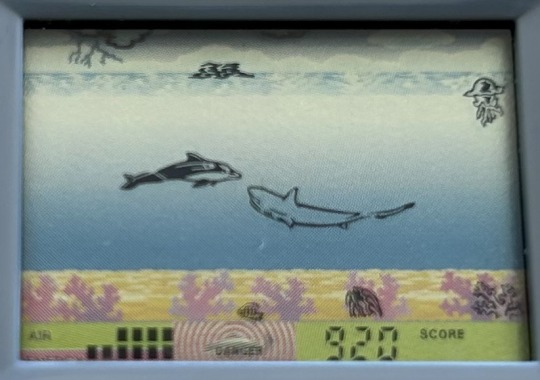
The soundscape is a few mere beeps and dare I say boops governed by your actions, and the majority of the backdrop is just a blue gradient… of course, this means it doesn’t obscure sprites like some other LCD games’ busy backgrounds. Those sprites are lovely, distinctive and detailed. Well, most of them anyway; some of the enemy critters don’t show up well on this tiny screen.
From what I could tell of the first unit, it tries to make each level somewhat distinctive, with an adventure feel as you can start from any stage you’ve unlocked, while this second one is content to just up the speed and add a couple of new enemy types as you advance, making it more of a score-chasing action game. It does have some nice little touches though, like the land edges that border each stage, and the lightning storm in the skies above, while the printed sandy coral layer on the sea floor mitigates the lack of the stunning sky vista the first game had. The two complement each other well, and I feel a lucky collector indeed to now own both, even if the first one is busted and the second has an ever so small screen. I just love dolphin games that much!
3 notes
·
View notes
Text
The Last Thing I Learned
What is the last thing you learned?
Because life… is not a movie. Everyone lies. Good guys lose. And love… does not conquer all.
Buddy Ackerman – Swimming with Sharks (1994)
When I was a teenager, around the year that movie came out, I had a notebook filled with movie quotes. That was one of them. Now, after a (recent) series of unfortunate events, I was reminded of it and I’m still learning…

View On WordPress
2 notes
·
View notes
Photo

“We underdogs have to look out for each other, right?"
FULL NAME: Giulia Marcovaldo
BASED ON: Giulia (Luca)
FACE CLAIM: Danielle Galligan
PRONOUNS: She/Her
BIRTHDAY: October 1, 1994
CURRENT STATUS: Taken
Character Information
Giulia can recite the story from memory: her father was alone on his fishing boat, just as the sun was starting to set. Nights were long in the summer, and the waters of the Adriatic were still and peaceful. He was preparing to come home, when all of a sudden a splash! And again! Just a few feet from the boat something was thrashing, trying to get out of the jaws of a humongous shark! And Massimo, brave as he was, grabbed his knife from a crate and plunged it into the shark’s back!
The shark retreated, leaving behind an injured seal. Its wounds did not look terrible, but Massimo didn’t want to leave it at the shark’s mercy. With difficulty, he lifted the seal out of the sea, preparing to take it home, to bring it to the local vet.
He ducked into the cabin for just a moment, and when he returned, the seal was gone. In its place was a beautiful woman, the goddess Venus herself, lying between nets and crates of fish.
She said her name was Luna, and she was grateful to her rescuer.
Massimo fell in love. And the rest, as they say, is history.
Their love affair was short; Luna could not be far from the sea for long. She had no family left, save for the pod of Mediterranean monk seals she tended to hang around with, and so she wasn’t entirely accustomed to life on land. But she stayed, for a time, and visited as often as she could, until one day, Luna came back with a bundle in her arms.
“Her name is Giulia,” she said, holding her up for Massimo to see. And Massimo had never seen anything more beautiful than that little baby girl.
And so Giulia grew, in and out of the sea. Curious about absolutely everything and everyone that she happened across, with more questions than her mother or father knew what to do with. She slipped between her seal and her human skin with ease, until the time came for her to go to university.
Little Giulia, though not so little anymore, wanted to study the stars she had looked at through two sets of eyes. And she did, for a time. Rome was a strange place compared to the little fishing village by the sea she called home, but it had its charms.
Until she was called home. Her mother, killed whilst out at sea. Her father in hospital, losing a hand by trying to rescue her once more.
And so Giulia abandoned her studies. Came home, and helped her father on the boat, and in the summer months, when the tourists came through, ran star-seeing tours up on the high hills surrounding the cove. She swam, of course, but she was careful. She didn’t dare go out into the deeper waters to swim with her mother’s kin. She stayed close to the shore, in her father’s sight, until her father passed as well.
Massimo’s death was peaceful, but it left Giulia adrift. She decided that a life of fishing and boat tours wasn’t for her; she wanted to find more selfies. More people like her. So she packed her things and she left, getting a one way ticket to England - to Swynlake, to try and find herself a pod.
✓ Loyal, courageous, scrappy
✖ Headstrong, competitive, distrusting
Character Suggestions
None
Current Relationships
None
Possible Relationships
Click here!
Magical Abilities
Selkie
2 notes
·
View notes
Text
Street Sharks Are Back! Celebrating 30 Years of Action and Adventure
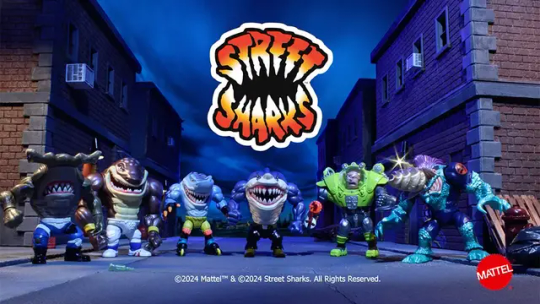
The new Street Sharks figures feature real-feel skin, tons of articulation, chomping jaws, and modular shark cages that can be combined to make bigger cages. At 6-6.5 inches tall, these Ripster, Slash, and Jab figures are perfect for any nostalgic display you can set up. Each figure comes inside its modular cage, but it won’t stay in there for long, it’s starting to break out! We’re sure that we’re going to love these figures almost as much as Vin Diesel loved the OG Street Sharks action figures that first launched in 1994.
Get ready to dive into '90s nostalgia! Mattel has officially announced the revival of the iconic franchise Street Sharks. These half-shark, half-human heroes are back to take on crime in style. Remember Ripster, Jab, and Slash? Well, they’re making a splash once again!
New Figure Details
- Ripster: The brave leader with realistic skin texture and articulated jaws.
- Jab: The prankster of the group, also featuring lifelike skin and a fierce bite.
- Slash: The rebel with a unique style and the same high-quality construction.
These classic figures come in nostalgic packaging that’ll transport you straight back to your childhood. But there’s a twist—updated articulation ensures they’re perfect for both longtime fans and newcomers.
Exclusive Goodies
- Walmart Exclusives: If you’re a collector, don’t miss the exclusive debut at Walmart Collector Con on March 15. Grab yours before they swim away!
- Street Sharks Apparel: Want to look cool while reminiscing about the good old days? Mattel is also releasing exclusive Street Sharks clothing on MattelCreations.
- Year-Long Celebration: The 2024 Street Sharks anniversary will be jam-packed with surprises. Expect more fashion collaborations, additional figures, and even comic books.
Dive into the Action!
So, if you ever dreamed of rollerblading and fighting crime as a shark, now’s your chance! The Street Sharks are back, and they’re ready to make waves in your collection. Don’t miss out!
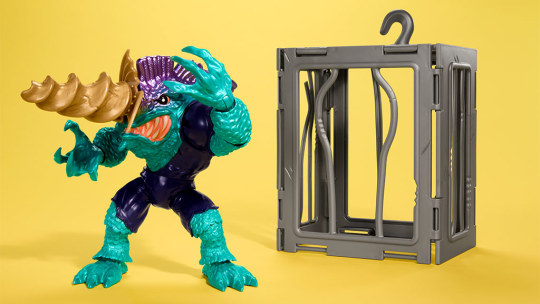
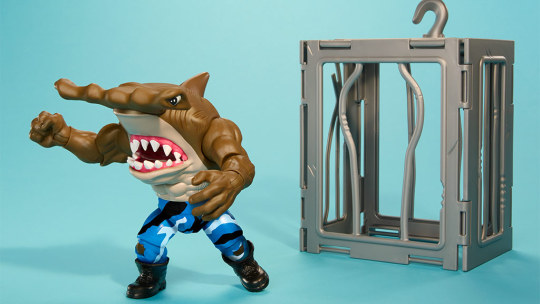

Read the full article
0 notes
Text
Palau

If you're looking for an escape to a tropical paradise with picture-perfect island views, look no further than Palau. This small island nation in Micronesia is made up of 66 stunning islands, each with their distinct charm and natural beauty. From white sandy beaches, crystal-clear waters, and lush green forests, there's something for everyone to discover in Palau.
Beyond its breathtaking scenery, Palau offers a unique and fascinating cultural experience. The Palauan people have a long and rich history dating back centuries and have developed a distinctive way of life that is reflected in their traditions, language, and cuisine.
As you explore the islands, you'll find yourself immersed in a world of ancient rock formations, lush coral reefs, and exotic marine life. Palau has been named one of the world's best scuba diving destinations, providing visitors with an opportunity to swim with schools of colorful fish, rays, and even sharks.
For those looking for adventure on land, Palau won't disappoint. Hiking through dense green forests, visiting ancient stone monoliths, and exploring hidden waterfalls are just a few of the many activities that Palau has to offer.
But it's not just outdoor enthusiasts that will find something to love in Palau. History buffs can visit the remains of the island's Spanish and Japanese occupations, while art lovers can appreciate the intricately crafted traditional carvings and pottery created by Palauan artisans.
Despite its relatively small population, Palau is known for its warm hospitality and welcoming spirit. Visitors can enjoy a variety of local dishes, including fresh seafood, tropical fruits, and dishes cooked in traditional underground ovens.
No matter what your interests are, Palau is sure to captivate and surprise you with its unique blend of natural beauty, cultural richness, and warm hospitality.
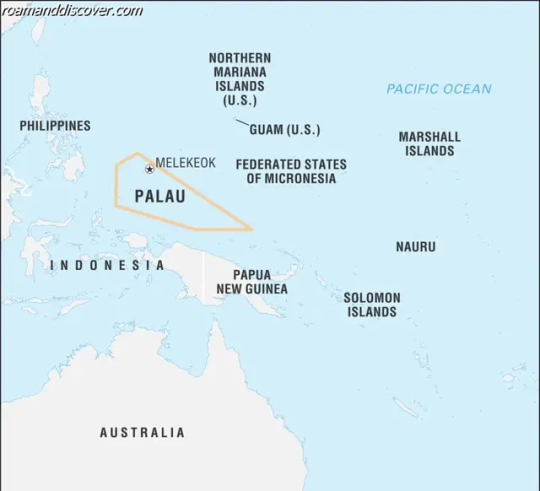
Etymology
The name Palau comes from the Palauan language and means "place of rendezvous." This refers to the island cluster's historic role as a hub of trade and interaction among various Pacific island cultures. Another Palauan legend attributes the name Palau to the story of two lovers from different islands who reached each other by swimming to a common point called Palau.
Spain, which claimed Palau in the late 16th century, called the islands Las Islas Encantadas, meaning "the enchanted islands," because of their stunning landscapes and rich biodiversity. During the German colonial period at the beginning of the 20th century, Palau was known as the Pelew Islands, which was a mispronunciation of its original name. It wasn't until Palau became an independent nation in 1994 that it officially adopted its original name as the Republic of Palau.
The name Palau reflects the unique cultural and linguistic heritage of the islands, which has been shaped by centuries of trade, migration, and colonialism. Despite its small size and relative isolation, Palau has a rich and complex history and culture that continues to evolve and thrive in the modern era.
History
The history of Palau is as diverse and rich as the nation itself. The Spanish explorers were the first to set foot on Palau's shores in the 16th century, but it was the Germans who established the first settlement on the islands in the late 19th century. The Spanish and German colonial periods were relatively brief, lasting only a few decades each.
During World War I, Japan wrested control of Palau from the Germans and went on to rule the islands for several decades. The Japanese built a number of military installations on the island group and established a strong presence in the region. Many of these historic sites, including Japanese gun emplacements and bunkers, can still be seen on Palau today.
After World War II, Palau remained under US administration as part of the Trust Territory of the Pacific Islands until 1994, when it finally gained its independence. The United States played an active role in assisting the Palauan people to rebuild and develop their country during its formative years as an independent nation.
The new country faced many challenges in its early years, including a lack of infrastructure and limited natural resources. However, with the help of the international community, Palau was able to establish itself as a thriving center of commerce and tourism. Today, visitors from all over the world flock to the island nation to experience its unique blend of natural beauty, rich cultural heritage, and modern amenities.
Throughout its history, Palau has remained steadfastly committed to preserving its natural wonders and cultural treasures. The government of Palau has implemented a number of initiatives to protect its coral reefs, forests, and endangered species, which are major draws for tourists. Palau also places a strong emphasis on sustainable development and eco-tourism, recognizing that its long-term prosperity depends on the health and vitality of its natural resources.
the history of Palau is one of resilience, diversity, and transformation. From its colonial past to its present-day status as an independent nation, Palau has overcome numerous challenges to emerge as one of the most vibrant and dynamic countries in the Pacific region.
Geology
Palau's rock islands are one of the country's most unique geological formations. These limestone and volcanic islands have been eroded over millions of years, creating a stunning landscape of over 200 mushroom-shaped islets rising from the sea.
The rock islands' limestone formations are considered some of the oldest in the world, dating as far back as 35 million years. They were formed by the accumulation of coral and other debris on ocean floors which eventually emerged as limestone islands.
The limestone also contains a vast network of underwater caves, sinkholes, and tunnels formed by the erosion of water. These underwater formations have become popular sites for diving and snorkeling, offering a unique experience to explore the hidden wonders of the island's geology.
In addition to the limestone islands, Palau is also home to several volcanic islands. These islands are characterized by their black sand beaches and towering basalt cliffs, offering a stark contrast to the white sandy beaches and coral reefs of the limestone islands.
One of the most famous examples of Palau's volcanic geology is the island of Babeldaob, which contains the famous Ngardmau waterfall. The waterfall is located in a volcanic crater and offers breathtaking views of the surrounding landscape.
Palau's geology offers visitors a unique and astonishing experience that cannot be found anywhere else in the world. From underwater caves to black sand beaches, the geological wonders of Palau are a testament to the country's natural beauty and diversity.
Geography
The Republic of Palau is an island country located in the western Pacific Ocean. It is situated in the Micronesia region and is composed of 340 islands, among which 8 larger ones are inhabited. Palau's capital city is Ngerulmud located on the largest island, Babeldaob, which hosts almost 70% of the country's total population.
Palau has a total land area of 466 square kilometers (180 square miles) and is located approximately 800 kilometers (500 miles) east of the Philippines. Its closest neighbors are the Federated States of Micronesia to the west, Indonesia to the south, and Papua New Guinea to the southwest.
The islands of Palau are largely of volcanic origin and are covered with lush tropical forests. With a population of around 22,000 people, Palau boasts of stunning landscapes and beautiful coastline, making it an ideal tourist destination.
The topography of Palau is characterized by mountains and dense forests. The highest peak is Mount Ngerchelchuus at 242 meters (794 feet). The islands are surrounded by a large lagoon and it has diverse diving sites and abundant marine life. The famous jellyfish lake located on Eil Malk island is a must-visit place as it is home to millions of golden jellyfish.
Palau has a tropical climate with high humidity throughout the year and two distinct seasons: the rainy season, which runs from May to November, and the dry season between December and April. Temperatures range between 25 to 31 degrees Celsius (75 to 89 degrees Fahrenheit) year-round, making it a perfect destination for holiday relaxation.
In terms of geography, Palau is divided into 16 states, with each state consisting of multiple islands. Due to the small size and diversity of the islands, most places in Palau can be accessed by boat or by land. On the other hand, the small size of the islands also makes it easy to explore the hidden gems of the island nation.
Palau has much to offer in terms of geography: beautiful tropical landscapes, diverse ecosystems, and picturesque small towns. The small size of the country means that tourists can expect a unique cultural experience and a chance to explore different corners of the country in a short amount of time.
Ecology
Palau is blessed with an awe-inspiring natural beauty that lies in its spectacular marine life, coral reefs, and endangered species. The coral reefs surrounding the islands of Palau are considered to be one of the most diverse marine ecosystems on the planet. The marine life in Palau is so vast and vividly colored that it is a common belief that Palau is a place where nature comes to life underwater.
The islands of Palau boast of a plethora of species ranging from the smallest of the tropical fish to the majestic dugongs, reef sharks, giant clams, and manta rays. The crystal-clear waters surrounding the islands are blessed with vibrant and colorful coral reefs that widen your eyes, and make you gasp in awe at their sheer beauty. The stunning underwater world of Palau is an essential part of the ecology of these islands, which draws several tourists to explore its depths.
Palau's ecological significance is not limited to its marine life alone. With over a hundred species of birds, the jungles of Palau are equally attractive, as they are home to amazing flora and fauna. Palau's unique topography fosters endemic species of animals and plants that cannot be found anywhere else in the world. From the majestic Palau large flying foxes to the Palau railbirds, the island's wildlife includes some unusual species that are rare and endangered.
Palauan authorities are committed to preserving their rich natural heritage, which is affected by climate change, plastic pollution, and overfishing. Efforts are being made to protect the endangered species and the coral reefs that are essential to the island's ecosystem. The rich web of life in the coral reefs of Palau encourages several initiatives to conserve the fragile ecosystem of these islands.
Palau is a breathtaking place with an exceptional ecosystem, making it an ideal destination for nature enthusiasts. The crystal clear waters surrounding these islands and the diverse marine life make Palau's ecology unique, not to mention the endemic species of animals and plants that call this place home. Palau's beauty is not only confined to its marine world but extends to the lush jungles and forests, which are equally captivating. Palau's people, government, and visitors are working together to save the environment for the well-being of generations to come.
Biodiversity
Palau is renowned globally for its biodiversity, which is the result of unique geology and geography, and strict conservation efforts. Despite its small size, Palau boasts a rich array of flora and fauna, with over 1,300 species of plants, 700 species of fish, 160 species of birds, and 13 species of whales and dolphins. Palauan waters are home to six of the world's seven giant clam species.
Palau’s diversity is enriched by its mosaic of different habitats, ranging from tropical rainforests and mangroves to coral reefs and seagrass meadows. This diversity is incredibly important for Palauans as the ecosystem provides them with food, medicine, and other cultural resources.
The Palauan government has made a concerted effort to protect such diversity by implementing strict environmental protections that limit overfishing and destructive fishing practices while also preserving the pristine and unique Rock Islands Southern Lagoon. The creation of the Palau National Marine Sanctuary in 2015 secured a staggering 500,000 square kilometers of ocean from commercial fishing and other harmful activities, safeguarding one of the most biodiverse regions on the planet.
The Palau International Coral Reef Center (PICRC) is a research and conservation facility dedicated to preserving Palau's biodiversity. The center conducts scientific research on the marine ecosystems of Palau, such as monitoring coral reef health and finding ways to mitigate the impacts of climate change. Moreover, the PICRC educates and raises awareness among the Palauan populace and visitors about the importance of biodiversity in maintaining a healthy ecosystem.
the biodiversity of Palau is rich and unique, and it is a vital resource for the local people. The Palauan government recognizes the fragility of these treasures and has made an impressive effort in its preservation. By doing so, the government has ensured that Palau's biodiversity is available and enjoyed by future generations.
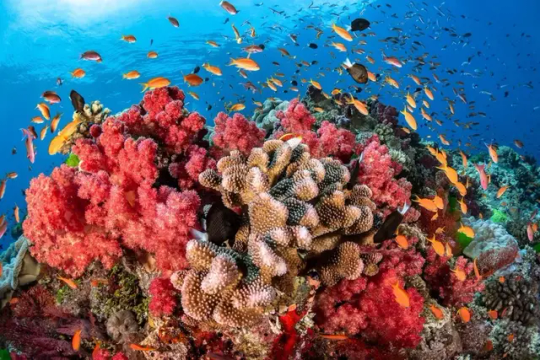
coral reefs
Climate
Palau has a tropical climate that is characterized by high humidity and constant heat throughout the year. The average temperature on the islands ranges from 26°C to 28°C, with the peak temperatures occurring from April to June. The weather is generally mild and pleasant, with occasional rainfall and thunderstorms during the rainy season from July to October. However, the islands are blessed with ample sunshine, and tourists can enjoy sunbathing and water sports activities throughout the year.
The climate of Palau has a significant effect on the marine ecosystem of the islands. The warm waters surrounding Palau provide an ideal habitat for an array of marine life, including over 1,300 species of fish and over 700 species of coral. Furthermore, the tropical climate supports the growth of the world-renowned Palauan rock islands and marine lakes.
Despite the pleasant weather, visitors to Palau should be prepared for heavy rainfalls and occasional typhoons during the rainy season. The islands are prone to floods and landslides during this period, and travelers should take necessary precautions. mosquitoes and other insects thrive in the tropical climate, so insect repellent is essential.
It is worth noting that the tropical climate of Palau is vulnerable to the effects of climate change. Palau has already experienced rising sea levels and stronger typhoons, and the future of the islands' ecosystem is uncertain. The government and communities of Palau are taking steps to mitigate the effects of climate change, such as banning single-use plastics and promoting sustainable tourism practices.
the tropical climate of Palau is one of the main attractions of the islands. Visitors can enjoy the warm weather and delightful waters surrounding them throughout the year. However, travelers should also be aware of the potential risks of the rainy season and the importance of preserving the unique environment for future generations.
Environmental issues
As an island nation in the Pacific, Palau is particularly vulnerable to the effects of climate change. Rising sea levels, stronger storms, and ocean acidification are all pressing environmental concerns for the Palauan government and its citizens. As a result, Palau has become a global leader in addressing these issues and is committed to reducing greenhouse gas emissions in line with international agreements.
In addition to climate change, Palau is battling plastic pollution and overfishing. The country has banned single-use plastics including bags, straws, and cutlery, and implemented a "cash for trash" program that incentivizes recycling. Palauan officials have also worked to establish a network of marine protected areas to safeguard the vibrant coral reefs and marine life that are so critical to the islands' tourism industry and way of life.
Palau's government has been outspoken about the need for global action on these issues and has taken steps to raise awareness among other countries and international organizations. In 2018, Palau hosted the Our Ocean Conference which brought together delegates from around the world to discuss and commit to marine conservation efforts.
Despite these efforts, challenges remain. The country's small size and limited resources mean that it must rely on international aid and cooperation to effectively combat these environmental issues. But Palauans are highly motivated to preserve their unique and fragile ecosystem, and the world can learn a great deal from their innovative and proactive approach to environmental protection.
Politics
Palau is one of the youngest democracies in the world, having gained independence from the United States in 1994. The country has a unique political system, which allows traditional leadership to coexist with modern democratic institutions. Palau is divided into sixteen states, each of which has its own governor, legislature, and judiciary. The state governments are responsible for delivering public services and maintaining local infrastructure.
At the national level, the government of Palau operates under a presidential system with three separate branches: the executive, legislative, and judicial. The President serves a maximum of two four-year terms and is directly elected by the people. The President's cabinet of sixteen ministers is appointed by the President and confirmed by the Senate. The Senate is comprised of sixteen members, one from each of the states, who are elected for four-year terms. The House of Delegates is composed of members elected to two-year terms from each of the states, with the number proportional to population size.
One of the most unique features of the Palauan political system is the Council of Chiefs, which acts as a traditional advisory body to the President and the Senate. The Council is made up of chiefs chosen by the traditional leaders of each state, and its members are appointed for life. Although the Council does not have any legal power, its opinions are highly regarded, and it provides a valuable link between traditional and modern governance institutions.
Another unique aspect of Palauan politics is the country's system of enforcing its Constitution. Palau has an independent Constitutional Review Commission that reviews all proposed legislation to ensure that it complies with the Constitution. If the Commission finds that a proposed law is incompatible with the Constitution, it must be amended or abandoned. This ensures that the Constitution remains the highest legal authority in the country and protects the rights of the people.
Since independence, Palau has developed a reputation as a beacon of democracy in the Pacific region. The country has held ten successful national elections, and its government is held accountable by a free and vigorous press.
Read the full article
0 notes
Text

The animals are on the lose here at Hivid with the manager's specials. That's right, come see the awesome deals we have right now with movies about animals. Here's what movies are on the manager's special display for this round:
An American Tail: Fievel Goes West (1991) is an animated Western adventure film about a mouse named Fievel who moves to the Wild West to start a new life.
Black Beauty (1994) is a family drama film that portrays the life of a young girl and her horse, Black Beauty, as they face various trials and tribulations while struggling to find their place in the world.
Homeward Bound II: Lost in San Francisco (1996) is a family adventure film about three pets, two dogs and a cat, who embark on a perilous journey through the city of San Francisco to reunite with their human family.
Hoot (2006) is a comedy-drama film that follows a group of children who set out to protect endangered owls from being killed by a construction company that plans to build on their habitat.
K-911 (1991) is a comedy-action film about a detective and his police dog partner who must solve a crime while dealing with their own personal problems.
47 Meters Down (2017) is a survival horror film about two sisters who become trapped in a shark cage at the bottom of the ocean and must find a way to escape before their air supply runs out.
Storm Boy (2019) is a family drama film that tells the story of a young boy living in rural Australia who forms a strong bond with a pelican and learns valuable life lessons about love, loss, and the environment.
Home on the Range (2004) is an animated musical western comedy film about a trio of dairy cows who embark on a mission to save their farm by capturing a notorious cattle rustler.
Madagascar 3: Europe's Most Wanted (2012) is an animated comedy film about a group of zoo animals who escape from Africa and embark on a journey through Europe, encountering new friends and foes along the way.
Don't forget these manager's specials are only on offer for a short time so grab them before they gallop, fly and swim away. The price for each movie is:
L$79 for a transfer version
L$99 for a copy version
So, what are you waiting for, head on down to Hivid and have a wild time. Hivid - Bringing People Together
1 note
·
View note
Text
Swimming with Sharks 2022
Swimming with Sharks is een miniserie met Diane Kruger en Kiernan Shipka, gebaseerd op de gelijknamige film van 1994.
Swimming with Sharks is een Amerikaanse miniserie gebaseerd op de gelijknamige film van 1994. In deze miniserie worden de hoofdrollen vertolkt door Diane Kruger en Kiernan Shipka.
Swimming with Sharks kan je momenteel bekijken op Amazon Prime. Deze miniserie telt 6 afleveringen van ongeveer 20 tot 25 minuten.
Diana Kruger kennen de meesten door haar rol als Helena in Troy (2004). Ook speelde ze…

View On WordPress
0 notes
Text
Shipwrecks to Explore in the Maldives
Exploring ships that sank a long time ago can be a special interest to anybody. Even if you are not that person, trying it out will be one of the most unforgettable experiences. If you are planning to visit the Maldives, plan a diving excursion to witness the colourful marine life that thrives amongst these shipwrecks.
Kuda Giri Wreck, South Malé Atoll
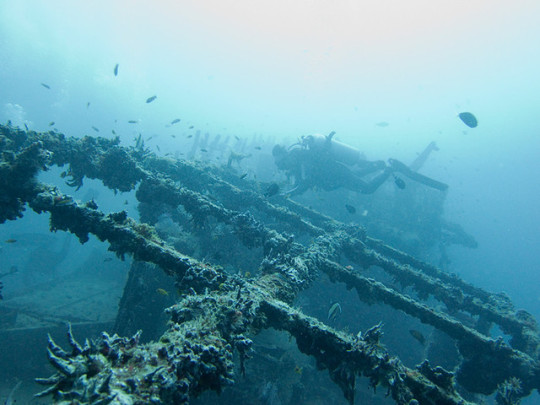
A sunken fishing trawler lies on the seabed a swimming distance from the nearby reef ‘Giri’, southwest of Dighu island. Since its sinking in 1994, soft coral has been growing into the trawler. But the vessel is so well preserved that the hull appears almost intact. It lays on the slope of the seabed in a way with the bow facing upwards and the stern below it about 30 metres from the surface.
It’s home to a large population of jackfish, batfish, glassfish and many other small fishes. You’ll be able to see it from about a 19-metre dive down at the location.
Machchafushi Wreck, Kudhi Maa, South Ari Atoll

This wreck was caused neither by an accident nor by abandoning a ship. A huge Japanese cargo ship was intentionally sunk in 1998 in order to create the wreck. Now, this artificial reef is teeming with marine life from tiny batfish, and pufferfish to large lionfish.
This is one of the wrecks in the Maldives divers are most attracted to. You’ll be able to snap some epic underwater photos here.
The Machchafushi wreck is visible from 12 to 30 metres below the surface. You can even enter the interior of the vessel through the access points of the hull on either side.
SS Sea Gull, North Malé Atoll

Even a 1000-tonne ship won’t last for centuries at the bottom of the sea where the ever-growing corals are. The steamship SS Sea Gull sank in 1879 while sailing from London to Calcutta. Now, the wreck is hard to spot as the corals have taken over most of the ship and the parts of the ship are scattered on the seabed.
It’s located northeast of Gaafaru island. The ship’s anchor sticks out at low tide and usually sits just about a metre beneath the surface. But the ship was split into two halves and stationed on each side of the reef ridge. The deepest parts of the wreck are up to 30 metres below the surface.
This location is swarming with stingrays, eels and barracudas in some parts of the year. And it’s one of the most mysterious sights you want to catch on your stay in the Maldives.
The Shipyard, Lhaviyani Atoll

This spot is unique. A ship’s bow sits erected out of the sea as the rest is submerged and stuck in coral. If the waters are clear, another wreck which is about 28 metres below the surface gets noticeable. This coral-rich area is filled with a variety of marine life such as sponges, anthias, batfish, angel fish, and even stingrays in the deeper rifts in the coral formation.
Lady Christine, North Malé Atoll
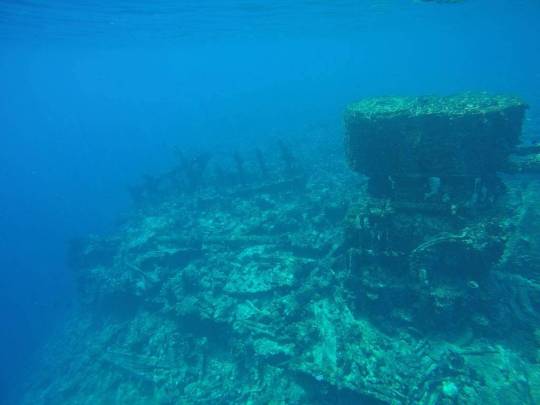
In 1974, Lady Christine was sailing the area laying communication cables and conducting an underwater survey. Unfortunately, it ran into a coral reef and sank. What is left of it is the bow protruding out of the water and the scattered remains. However, the sad story of Lady Christine had a colourful ending; now, the ship is bound to the coral reef and the natural cave system beneath it and has become home to spectacular marine life. Witness turtles, sharks, and rays, and a spectrum of tiny species that’s found a home around the wreck.
Not sure where and how to start? Some hotels like Holiday Inn Resort Kandooma Maldives offer an exciting Wreck Safari tour that’s perfect for divers on holiday.
0 notes
Text
The Unknown Fate of Two Imaginary Girls (plus a Hammerhead)
Optimized 1 minute 30 second read.
Thursday morning, 14 July 2022.
The Unknown Fate of Two Imaginary Girls (plus a Hammerhead)
Dream # 20,296-04.
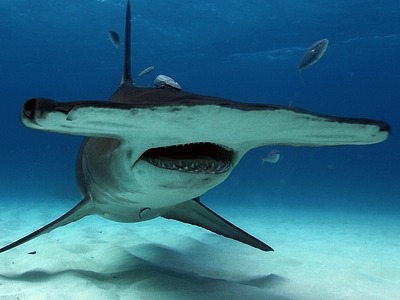
My dream remains in a mode of combining and transforming abstract patterns and liminal forms, quite surreal on one level and realistic on another. The content is more typical of my first stage of sleep, being almost wholly water-based.
Without my waking-life identity, I enter mid-range liminality with the rendering of the Loomis Street house's porch. The Naiad factor is still residual here, rendering water (and two unfamiliar girls) to correlate with my metacognitive recognition of navigating the dream state. The Loomis Street house (unseen since February 1994) atypically seems several buildings south of where it is in its real-world location. In this case, it may be an underlying recognition of living near an intersection in waking life.
On the nature strip are two unfamiliar girls, sitting on their knees, facing each other on either side of a deep rectangular hole. I get the impression it relates to an ecological study of the area, which may affect people's houses. Having a total absence of memory of the Naiad factor (because of the natural but varying virtual amnesia caused by lack of consciousness), I perceive the girls as intrusive. Even though their work is probably official, I tell them to leave, mainly because they are somehow causing the porch to flood (even though there is no flooding elsewhere in the neighborhood).
The porch's floor is a mix of wooden planks and mud. (In real life, it was concrete.) The muddy areas are where planks are missing. I consider it is not stable enough to walk over, sensing deep water underneath (which makes no sense in light of the muddy ground areas), but that thought does not last.
I navigate a mix of underwater scenes and abstract patterns with indescribable content. I eventually summon a hammerhead shark to eat the two girls (who had been swimming though I no longer see them at this point), but it is half-hearted, and no drama unfolds. The hammerhead shark swims close to me, but there is no concern as it is like looking at a movie screen. The setting is under the porch, but I see part of a door frame above me.
0 notes
Text



BENICIO DEL TORO as REX
SWIMMING WITH SHARKS
1994 | dir. George Huang
#love a man in a suit#benicio del toro#beniciodeltoroedit#bdtedit#REX#swimming with sharks 1994#*benicioscenes.gif#mine#rexedit
22 notes
·
View notes
Photo

Silent Hills - Characters
Chloe Summers (age 9-10)
David (main antagonists) - inspiration Kevin Spacey (Swimming with Sharks 1994 and Se7en 1995) and The Thin Man (Little Nightmares II)
#silent hill#silent hills#game#horror game#horror#kevin spacey#silent hill david#david silent hill#chloe summers silent hill#silent hill chloe summers#chloe summers#クロエ・サマーズ#robbie the rabbit#ウサギのロビー#ultimate anna
4 notes
·
View notes
Photo




Kevin spacey appreciation challenge
16. Most underrated Kevin Spacey movie: Swimming with sharks (1994), Kevin as Buddy Ackerman.
“What, your job is unfair to you? Grow up, way it goes. People use you? Life’s unfair? Grow up, way it goes. Your girlfriend doesn’t love you? Tough shit, way it goes.”
Because life is not a movie.
Thanks to @afirmgraspoftheobvious for the inspiration.
#swimming with sharks#kevin spacey#kevin spacey 30days appreciation challenge#buddy ackerman#il prezzo di hollywood#hollywood#movie#underrated movies#best actor#movies#1994
33 notes
·
View notes
Photo

Title: Swimming with Sharks (1994)
Vote: 7/10
This movie is heavy to watch. It shows us the worst side of Hollywood and that to survive in that unruly world you have to kill your own morality like the protagonist does. A nihilistic view of life but I think anyone who has worked in that field for a while will end up thinking so.
0 notes
